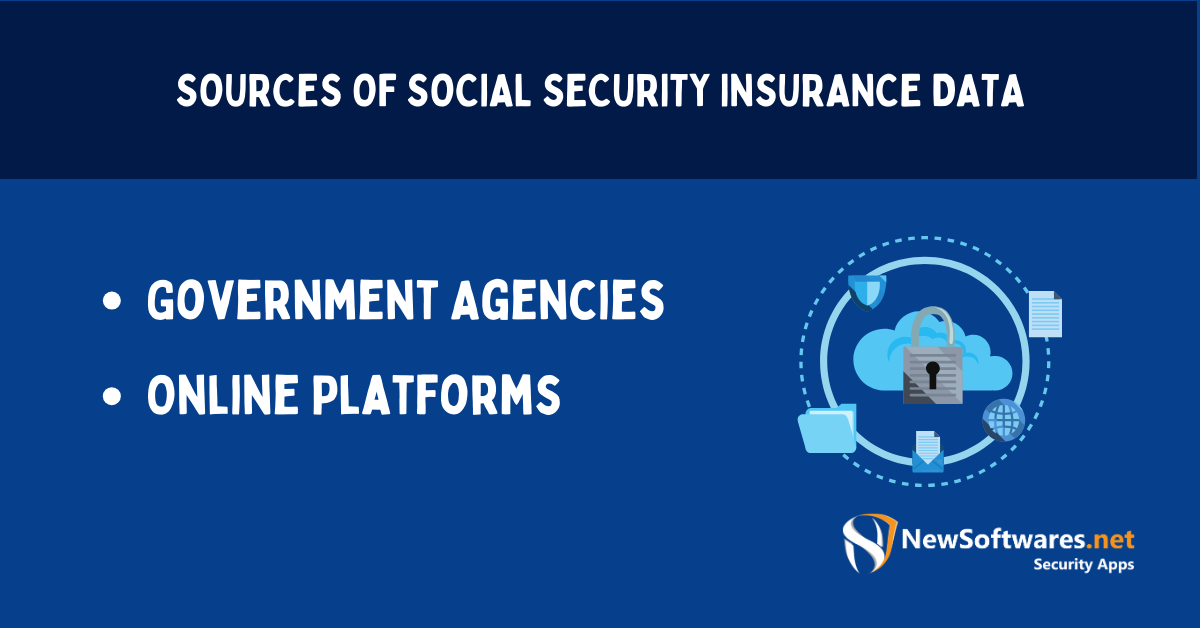Social Security Insurance data can typically be obtained from official government agencies responsible for Social Security, but only with proper authorization and for legitimate purposes.
Social Security Insurance data is a valuable resource for individuals and organizations seeking to understand, analyze, and plan for the future. With the right data, one can gain insights into trends, make informed decisions, and ensure the security of their financial well-being. I will explore where to find Social Security Insurance data, how to request it, and important considerations regarding privacy and security.
Understanding Social Security Insurance Data

Social Security Insurance data provides a comprehensive view of the benefits, payments, and demographics associated with the Social Security Insurance program. By analyzing this data, individuals can understand the program’s impact and make informed decisions about their retirement plans, disability benefits, and survivor benefits. It is important to recognize the significance of Social Security Insurance data and its role in shaping policies and programs that support individuals in their time of need.
The Importance of Social Security Insurance Data

Access to accurate and up-to-date Social Security Insurance data is crucial for making informed decisions about retirement planning and managing financial security. This data helps individuals estimate their expected benefits, calculate the impact of early or delayed retirement, and understand how different life events, such as marriage or divorce, may affect their eligibility for benefits. Moreover, researchers, policy analysts, and government agencies rely on this data to shape and evaluate social welfare programs.
For example, consider a hypothetical scenario where an individual retirement plans. By accessing Social Security Insurance data, they can input their personal information, such as age, income, and work history, into retirement calculators. These calculators utilize the data to estimate the individual’s future benefits based on different retirement scenarios. With this information, individuals can make informed choices about when to retire and how it will impact their financial well-being.
Furthermore, Social Security Insurance data is valuable for individuals, policymakers, and researchers. By analyzing the data, policymakers can identify trends and patterns in benefit distribution, demographic changes, and program expenditures. This information allows them to evaluate the program’s effectiveness and make informed decisions about potential policy changes or improvements. Researchers can also utilize the data to conduct studies on the impact of Social Security Insurance on various population groups, such as the elderly, disabled individuals, or survivors of deceased workers.
Key Components of Social Security Insurance Data
Social Security Insurance data comprises various key components that provide insights into the program’s operation and impact. These components include data on beneficiary profiles, income, current and projected benefits, eligibility criteria, and program expenditures. Understanding each of these components helps individuals and organizations analyze the effectiveness of the Social Security Insurance program and advocate for necessary changes or improvements.
Beneficiary profiles within the Social Security Insurance data provide detailed information about the individuals receiving benefits. This includes demographic data such as age, gender, marital status, and disability status. By analyzing beneficiary profiles, policymakers can identify groups that may be disproportionately affected by the program and develop targeted interventions to address their specific needs.
Income data within the Social Security Insurance data allows for a comprehensive understanding of the monetary circumstances of beneficiaries. This data includes information on wages, self-employment income, and other sources of income. By examining income data, researchers can assess the adequacy of benefits and identify potential gaps in the program’s coverage.
Current and projected benefits data provide insights into the amount and duration of benefits beneficiaries receive. This data helps individuals plan for their retirement and understand the monetary implications of their decisions. It also allows policymakers to evaluate the program’s sustainability and make necessary adjustments to ensure its long-term viability.
Eligibility criteria data within the Social Security Insurance data shed light on individuals’ requirements to qualify for benefits. This data includes work history, earnings thresholds, and disability criteria. Understanding eligibility criteria is essential for individuals to determine their eligibility for benefits and for policymakers to assess the program’s inclusiveness.
Program expenditures data provides information on the financial resources allocated to the Social Security Insurance program. This data includes administrative costs, benefit payments, and funding sources. Analyzing program expenditures helps policymakers evaluate the program’s efficiency and identify areas where resources can be allocated more effectively.
Sources of Social Security Insurance Data

There are several sources from which one can obtain Social Security Insurance data. Government agencies and online platforms are vital in providing access to this appreciated resource.
Government Agencies and Social Security Insurance Data
Government agencies, such as the Social Security Administration (SSA), are the primary source for official Social Security Insurance data. The SSA maintains a vast data repository on benefits, payments, and recipients. The agency periodically releases reports, publications, and datasets that are easily accessible to the public. These resources provide detailed information on various aspects of the program, including retirement, disability, and survivor benefits.
Online Platforms for Accessing Social Security Insurance Data
In addition to government agencies, numerous online platforms offer Social Security Insurance data access. These platforms compile and organize data from various sources, making it easier for individuals and researchers to explore and analyze. Websites like the Social Security Administration’s official website provide user-friendly interfaces, interactive tools, and customizable calculators to help individuals estimate their benefits and retirement plans. Third-party websites and financial planning tools offer valuable insights and resources to enhance understanding and decision-making.
How to Request Social Security Insurance Data?
Suppose the available Social Security Insurance data does not meet your specific needs. In that case, you can request additional information directly from government agencies or utilize online platforms that assist with data requests.
Steps to Requesting Data from Government Agencies
You will typically need to submit a formal request to request specific Social Security Insurance data from government agencies like the SSA. This could be in the form of a written letter or an online application. Clearly state the type of data you are requesting and the purpose for which it will be used. Be prepared to provide any necessary supporting documentation or justification for your request. Please note that some requests may be subject to fees or processing time.
Utilizing Online Platforms for Data Request
Alternatively, individuals can utilize online platforms specifically designed to simplify the process of requesting Social Security Insurance data. These platforms provide step-by-step guidance, pre-filled forms, and document templates to streamline the data request process. By leveraging these resources, individuals can save time, ensure accuracy, and optimize their chance of receiving the desired data.
Privacy and Security Concerns with Social Security Insurance Data
While acquiring Social Security Insurance data can be invaluable, privacy and security concerns must be addressed to protect personal information and sensitive data.
Protecting Your Personal Information
When accessing Social Security Insurance data, it is essential to be cautious with personal information and take steps to protect sensitive data. Ensure you access data from official sources or trusted platforms to minimize the risk of fraud or identity theft. Avoid sharing personal information with unauthorized individuals or websites, and regularly monitor your accounts and credit reports for any suspicious activity.
Understanding Data Privacy Laws and Regulations
Data privacy laws and regulations are vital in safeguarding Social Security Insurance data. Familiarize yourself with applicable laws and rules, such as the General Data Protection Regulation (GDPR) or the Health Insurance Portability and Accountability Act (HIPAA), to ensure compliance and protect yourself and others involved in data collection, storage, and analysis. Moreover, stay informed about updates and changes to these regulations to maintain the highest level of data security.
Interpreting Social Security Insurance Data
Once you have obtained Social Security Insurance data, understanding how to interpret it is crucial for making informed decisions and drawing accurate conclusions.
Decoding Data: What Does It All Mean?
Interpreting Social Security Insurance data requires attention to detail, contextual analysis, and familiarity with relevant terms and concepts. Take the time to understand the data points, variables, and methodologies used in collecting and presenting the data. Consult official documentation guides or seek expert advice to ensure accurate interpretation. A solid foundation of knowledge and understanding will let you unleash the full potential of Social Security Insurance data.
Making Use of Social Security Insurance Data in Personal Planning
Lastly, once you have interpreted Social Security Insurance data, leverage its insights to make informed decisions about your planning. Use the data to estimate your retirement benefits, explore different scenarios, evaluate the impacts of varying circumstances, and adjust your financial plans accordingly. Using the valuable information provided by Social Security Insurance data, you can better prepare for the future and secure your financial well-being.
Key Takeaways
- Social Security Insurance data is highly sensitive and regulated.
- Always ensure you’re accessing data legally and ethically.
- Improper handling of such data can lead to serious legal consequences.
- Verify the source’s authenticity to avoid potential scams or misinformation.
- Personal data should be treated with the utmost confidentiality and respect.
FAQs
Can I access my own Social Security Insurance data?
Individuals can typically request their records from the relevant government agency.
Is it legal to buy or sell this data?
No, trading in personal Social Security Insurance data without proper authorization is illegal.
How is Social Security Insurance data protected?
Various privacy laws, encryption, and secure databases protect data.
Why would someone need this data?
For personal verification, benefits processing, or official research with proper authorization.
Can I use this data for employment verification?
Only with the individual’s explicit consent and in compliance with applicable laws.
Conclusion
In conclusion, Social Security Insurance data is a valuable resource for individuals, researchers, and organizations. By understanding where to find this data, how to request it, and the considerations regarding privacy and security, individuals can make informed decisions, plan for the future, and advocate for necessary changes. Interpreting this data accurately allows for better personal planning and helps maintain the integrity and effectiveness of social welfare programs. Accessing and utilizing Social Security Insurance data responsibly empowers individuals to secure their financial well-being and contribute to the overall welfare of society.
